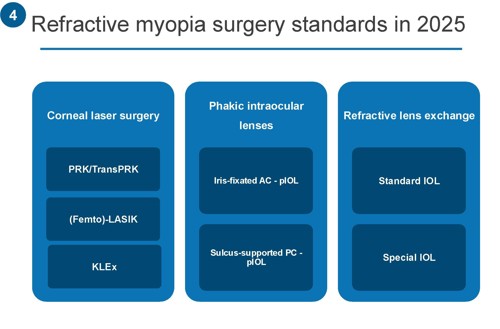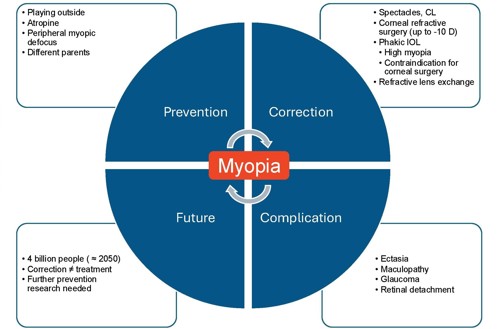Meetings, Congress News, Refractive, Phakic IOLs
The Short-Sighted World
Binkhorst Medal Lecture highlights need for further research on myopia.

Laura Gaspari
Published: Wednesday, October 1, 2025
Today’s ophthalmologists have a considerable number of ways to correct myopia, but this year’s presenter of the prestigious Binkhorst Medal Lecture says we need further research and treatments.
“Be aware that in 2050, we will have 4 billion people myopic in the world,” said Thomas Kohnen MD, PhD. “That’s maybe half of the population. Correction is not the treatment. It’s a growing problem worldwide and without a cure, but we can do some things.”
Professor Kohnen noted there are risk factors that are well known by the ophthalmological community, such as not spending enough time outside, a lot of near work (especially with digital devices and more pressure in educational systems), staying in dim light, and, ultimately, genetics. He explained that the development of lens power over time shows a decline across all age groups, with a steeper drop indicating the onset of myopia. This suggests the compensation is insufficient to counteract axial length growth, meaning there is no effective mechanism to compensate for myopia.
Ophthalmologists have some weapons to counteract myopia: first, by raising awareness among patients of the impact of lifestyle changes such as spending more time outside (especially for children), as outdoor recess has been demonstrated to reduce myopia onset by 50%; also by using atropine 0.1%, which has been demonstrated to be effective in slowing myopia progression with minimal side effects; and recommending myopic defocus lenses, which have shown to be effective in reducing myopia progression and axial elongation more than 50% in two years. Prof Kohnen warned about the rebound process if treatment is stopped, showing that the lowest rates of it are for those using glasses.

Refractive surgery, such as PRK/transPRK, LASIK, femtoLASIK, and KLEx, is another important option that has seen significant evolution over the past decades. Prof Kohnen presented meta-analysis data showing high safety and effectiveness rates for PRK, LASIK, and KLEx, with no superiority of any single procedure. There are now a lot of studies underway on the use of femtosecond and excimer lasers. Phakic IOLs (angle-supported, iris-fixated, and posterior chamber lenses), of which Prof Kohnen is a big fan, have expanded the possibilities for myopia correction, outperforming excimer laser in safety and satisfaction in moderate/high myopia cases.

One big issue facing the ophthalmological community is high myopia and the possible complications these patients can face even after refractive surgery and phakic IOL implantation, including cataract formation, ectasia, and retinal detachment. Prof Kohnen emphasised the importance of creating guidelines for refractive surgery and the need for continuous research and improvement, efforts in which ESCRS is heavily invested through new studies, an IOL classification project, and guidelines, not only for myopia but also for presbyopia. He recommended that ophthalmologists take a comprehensive approach when dealing with myopia. “Remember to treat the whole eye, not just a refractive error,” he said.
Prof Kohnen concluded with a call for reflection, quoting a 1934 article titled “Nationalism Against Science” that spoke of political shortsightedness as a threat to research and science. “Last week, Richard Parrish sent me this, and he wanted to republish this article to remind us of the near-sighted world we have,” he said.
Thomas Kohnen MD, PhD, FEBO is a professor and chair of the Department of Ophthalmology at Goethe University in Frankfurt, Germany.